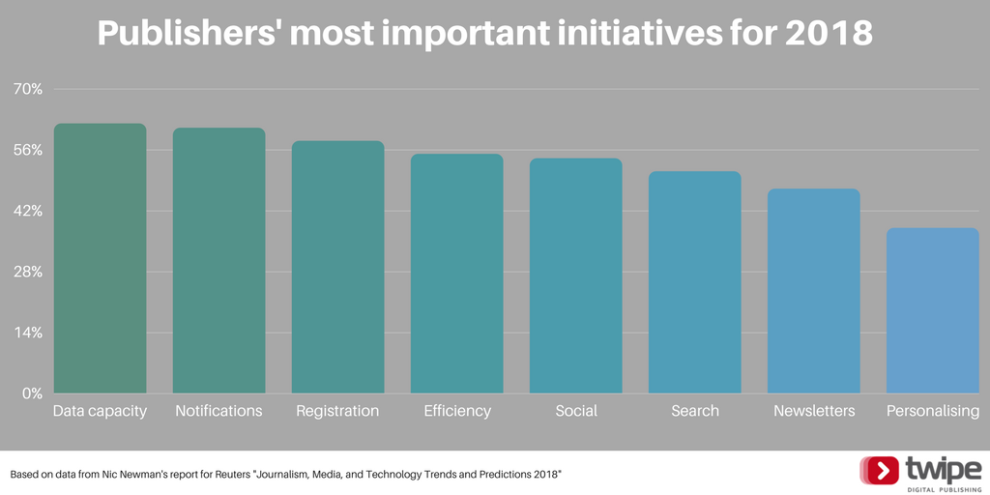The annual report from Reuters “Journalism, Media, and Technology Trends and Predictions 2018” is out and it’s full of interesting insights into how digital leaders in the publishing industry are focusing their efforts in 2018. The common theme that emerges is the growing importance of data and AI in the news industry. We also see that audio will grow in significance in 2018, and that digital subscriptions are the most important revenue stream for publishers.
Artificial intelligence isn’t going anywhere
Artificial intelligence is more than just a trend in the media industry right now, it will have a lasting impact on how we create, distribute, and consume news for years to come. That’s clear from the survey as well, with 72% of digital leaders planning to experiment with AI in 2018. Currently, the most common use of AI is delivering content recommendations for readers, while the uses of AI to automate workflow and improve commercial optimisation are tied for second. At fourth is the use of AI to find stories, known as ‘robot journalism‘.

“JAMES, your digital butler” was named as a development to watch in this report. JAMES is a joint project between Twipe and The Times and The Sunday Times that will use machine learning and AI to get to know the habits, interests, and preferences of readers in order to expose them to relevant content in their preferred format, channel, time, and frequency. This Google DNI-winning project will work to increase reader satisfaction and engagement and in turn accelerate subscription growth.
A pivot to audio?
Say goodbye to the “pivot to video”, 2018 will be the year of “pivot to audio”, with audio quickly becoming an important market for publishers. More than half of publishers surveyed will be focusing more on podcasts and content for voice activated-speakers, with innovative publishers using audio as more than just a way to distribute content. BBC has led the way in this, with their audio-native comedy “Inspection Chamber”, where listeners play a part in the story using their own smart speakers.
We will also see more developments in ‘hearables’—technologies designed to bring a range of smart technologies closer to our ears. 2018 will see New York start-up Waverly Labs release their much hyped ear buds with real-time audio translation, while Amazon’s new glasses will use a bone-conducting audio system to allow Alexa to be heard without a need for headphones.
Publishers placing more importance on developing data capacity
The report predicts that 2018 “could be the year when media companies recognise how critical data will be to their future success”. Publishers are realising this, with 2/3 of those surveyed stating that their most important initiative for 2018 will be improving their data capacity.

It’s good to see an increasing focus on notifications, as it one of the key ways to drive ePaper digital growth. If you also plan to improve your push strategy in 2018, make sure to keep our 4 guiding principles in mind.
Tied to the growing importance of better developing data capacity is the renewed focus on moving unknown readers to registered readers—not necessarily subscribers but at least known quantities. This aligns with publishers increasingly shifting from a mass reach strategy based on ads to a model based on maximising revenue from a smaller number of engaged readers. By registering readers, publishers are able to deliver a more personalised experience and to better understand their audience.
A registered reader – as opposed to an anonymous one – is far more valuable to the business than the vast majority of our audience.
Nick Hugh, Telegraph CEO
Revenue streams to focus on in 2018
The perennial problem in news: how to fund quality journalism. We’ve seen before what makes readers willing to pay for online news, and in what ways they are willing to pay, but there is no one best method. Publishers are hedging their bets as well, with the majority pursuing multiple revenue streams.

2018 will see publishers placing more of a focus on subscriptions, but for some publishers already focused on subscriptions, this brings a new worry: will they need to compete with other publishers for their readers?
More publishers will focus on reader revenue … but will the number of readers who are willing to pay increase? Otherwise we will end up competing for the same subscription money.
Jan-Willem Sanders, publisher at Follow the Money
Different publications attract different types of readers, so to increase your ability to convert them into paid readers, make sure to identify the type of ‘news subscriber persona‘ you are targeting. Knowing this, you can then improve your conversion plan (see “Who pays for news and how to convert them”).
Video, branded content, and display ads will all remain important for publishers. We see an increasing importance placed on events and membership, following the ambitious goal from the Guardian of one million paying members by April 2019. Membership programs can also aid in the development of data capacity, as publishers can gain a better understanding of who their most loyal readers are.
This article was written by Mary-Katharine Phillips, Media Innovation Analyst at Twipe from 2017 – 2021.
